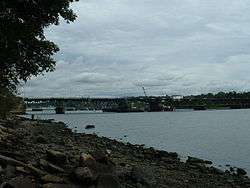Brightman Street Bridge
| Brightman Street Bridge | |
|---|---|
 | |
| Coordinates | 41°43′26.26″N 71°09′20.51″W / 41.7239611°N 71.1556972°WCoordinates: 41°43′26.26″N 71°09′20.51″W / 41.7239611°N 71.1556972°W |
| Carries | closed to all traffic |
| Crosses | Taunton River |
| Locale | Somerset to Fall River, Massachusetts |
| Characteristics | |
| Design | two-leaf bascule bridge |
| Total length | 922 ft |
| Longest span | 98 ft[1] |
| Clearance below | 27 ft |
| History | |
| Construction begin | 1906 |
| Construction end | 1908 |
| Opened | October 10, 1908 |
| Closed | October 11, 2011[2] |

The Brightman Street Bridge is a 922-foot (281 m) long, four-lane wide drawbridge spanning the Taunton River between the town of Somerset and the city of Fall River, Massachusetts. It was authorized in 1903 by the state legislature, and building took place between 1906 and 1908, when it opened full-time on October 10, 1908. It was closed to vehicular traffic on October 11, 2011.[2]
At the time of its completion, it was the widest bridge to span the Taunton River, as the Slade's Ferry Bridge, a steel swingspan bridge built in 1875 less than a quarter mile downriver, was barely a two lane bridge. It once served as the pathway for Route 6 and Route 138 to cross the river into Fall River. Now the Veterans Memorial Bridge (Bristol County, Massachusetts), just upstream, carries these routes between Somerset and Fall River.
Replacement and controversy
With the age of the bridge becoming a problem, as well as the rising costs of necessary upkeep and maintenance, talk began circulating about replacing the bridge as early as the late 1970s and early 1980s. Starting in 1983,[3] plans were put in place to replace the bridge with a new, higher and wider span 1,500 feet (460 m) upriver, which would span from a proposed flyover intersection with Route 79 on the Fall River side, to a new access road through the former site of Slade's Ferry Park in Somerset.
Plans were put on hold in 1989, when the Coast Guard protested the size of the opening of the bridge. Once details were worked out, work began in the late 1990s, but again with delays. This was due to money being taken away from the project for the well-over budget Big Dig project in Boston.[1] Again the work was delayed until costs could be met. A third problem arose in 2008, when inspectors questioned the quality of the cement used in the main pilings for the bridge. This caused yet more delays as inspections and tests were needed on the piers. Construction has since been completed on this new bridge.
The most recent controversy involving the bridge did not involve the bridge work at all, but rather involved the proposed building of a LNG terminal at Weaver's Cove, just to the north of the new bridge. In order to stop the LNG plan, community leaders pushed for keeping the bridge intact.[4] This project has met with fierce opposition from the surrounding community, as well as federal, state and local leaders, including Representatives Jim McGovern and Barney Frank, as well as Senators John Kerry and Scott Brown, all of whom have made appearances at various opposition rallies. The problems are twofold:
- For one, there is the belief that LNG tankers could be targets of terrorism, as an explosion of a tanker, whether on route or in port, could cause catastrophic damage and loss of life in the community.
- There is also the concern about LNG transportation requirements, which would involve the closing of not just the new bridge, but also the Braga Bridge, for several hours at a time, thus cutting off vital trade routes in the area.
All of this has led to a rather ironic campaign to keep the original bridge standing after the new one is completed.[5] So far the campaign has been successful in keeping the old bridge standing, but whether or not it stops the LNG terminal from being built is still undetermined.
See also
References
- 1 2 http://www.srpedd.org/Ch7bridges.pdf
- 1 2 "Requiem For A Bridge," Herald News, October 11 2011"
- ↑ "New bridge on schedule despite budget cutbacks," Herald News, 18 April 2002
- ↑ O Jornal, Editorial, July, 2003
- ↑ "Obstacles keep hope alive for foes of Fall River LNG facility," Boston Globe, 22 Aug 2005.